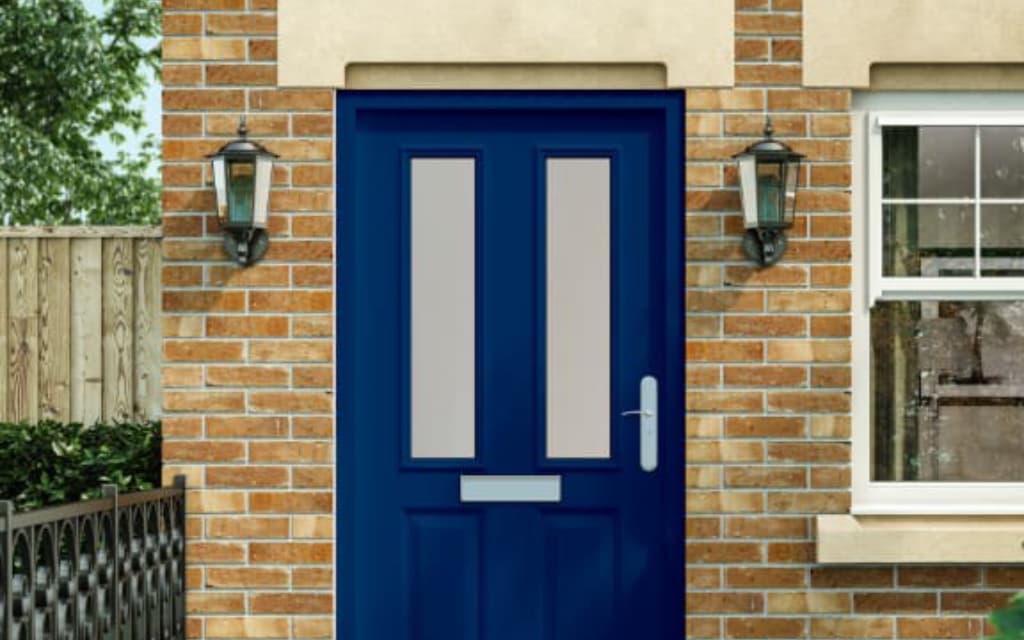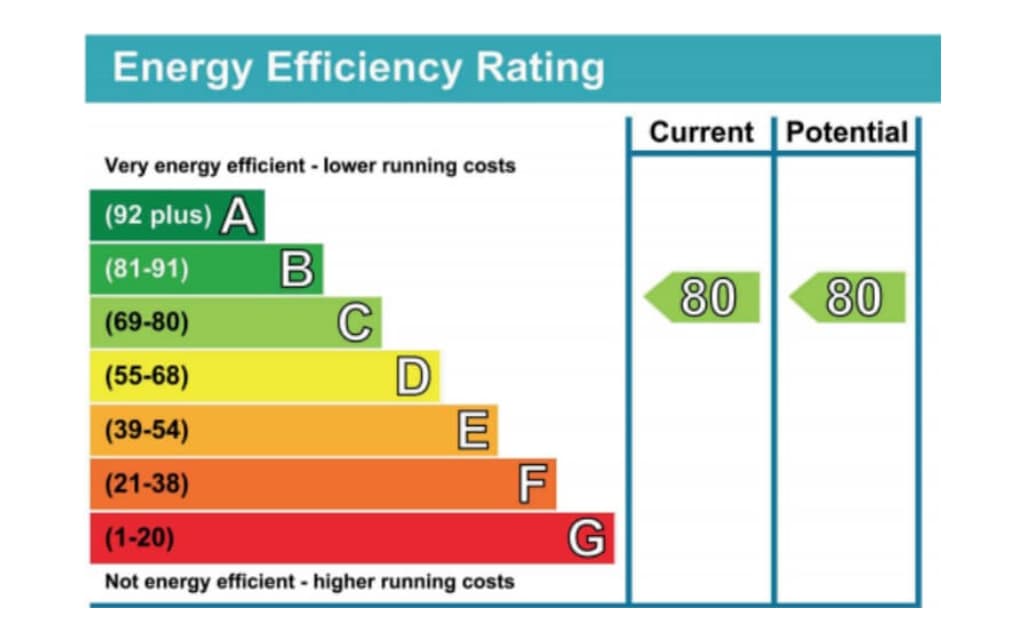A composite door is made from a combination of durable and long-lasting materials. These doors normally have a solid timber core, with other materials that surround them, such as UPVC, laminate, and fibreglass. This makes a composite door dense and robust, providing security and insulation for your home or business.
In this comprehensive guide to composite doors, we explore their pros and cons, how secure composite doors are, how they compare to other doors, what they cost, and much more.
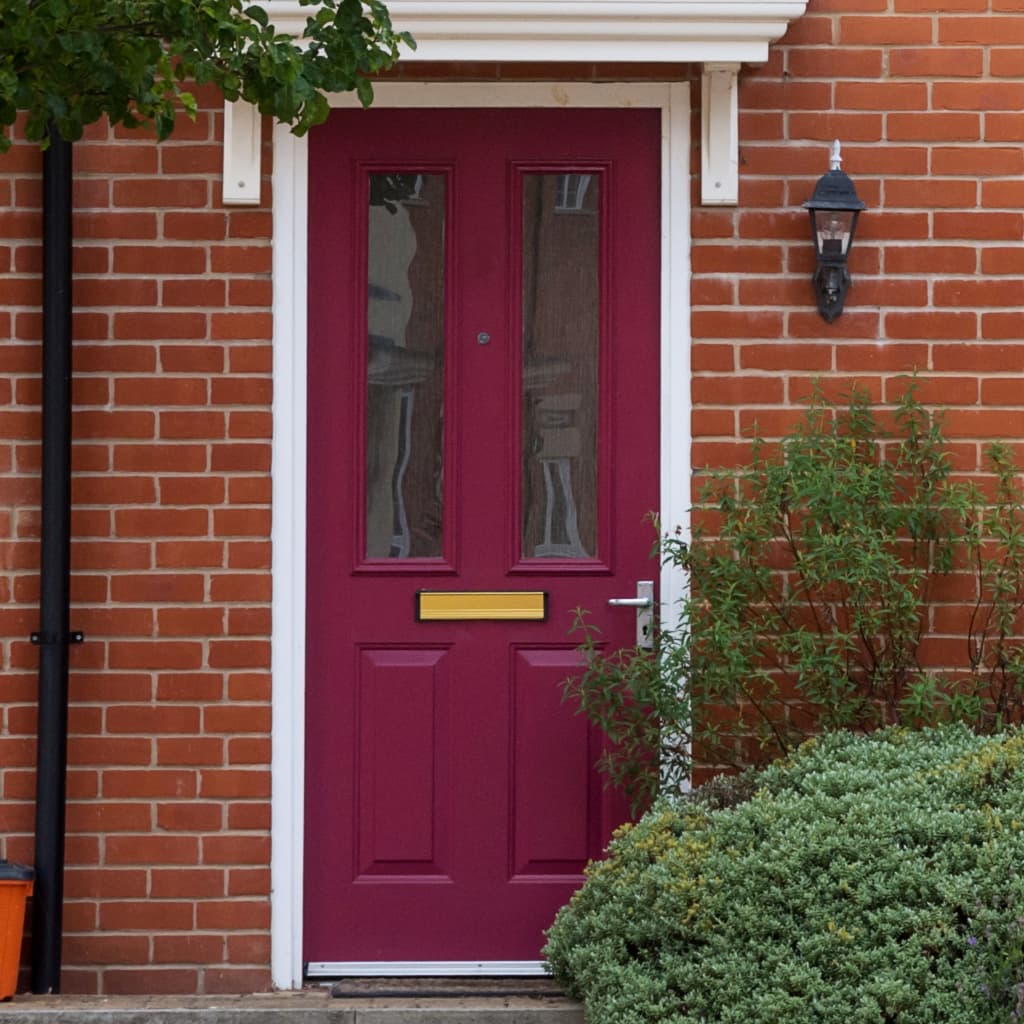
Why have composite doors become so popular?
The popularity of composite doors has risen over the past decade, with UPVC panel doors previously dominating the market. It’s easy to recognise why composite doors are so popular. Composite doors are designed with character and style in mind, whilst offering superior security for your home. Whether you have a traditional or modern property, a composite door can be easily adapted to complement a home’s style.
Understanding Composite Doors
A wide array of composite doors is available in the market, often tailored and custom-fitted to meet specific requirements.
Definition of a composite door
A composite door is a type of external door used for security, insulation, and aesthetic appeal. They are so named because they’re composed of multiple materials rather than a single material, hence the term “composite”.
Materials used in a composite door
These doors are usually constructed from a combination of materials such as PVC, wood, insulating foam, and glass-reinforced plastic (GRP). This diverse mix of materials results in a door that possesses the strength and durability of steel, the aesthetic appeal of wood, and the low maintenance benefits of UPVC. The insulation properties can also contribute to energy efficiency, reducing heat loss from the home.
How composite doors are made
A composite door is built in a quality-controlled factory by following this process:
Step 1:
The frame of the door is built first. It will typically be made of reinforced structural members which have been cut to exact specifications.
Step 2:
The hardwood or UPVC inner frame is then laid down to fit the outer frame. At this point, other reinforcing materials can be added for extra strength.
Step 3:
The locks, hinges, and latches are added and secured to the solid frame.
Step 4:
The front and rear faces are added at this point and are typically made of durable UPVC or GRP.
Step 5:
Expanding polyurethane foam is injected between the faces at high pressure, to ensure that it fully penetrates the door structure. Alternatively, the core can be made from solid timber.
Step 6:
The door is finished by hand, which includes cutting and fitting the windows, and installing the letterbox and any door furniture.
Pros and Cons of Composite Doors
Composite doors are a fantastic investment when upgrading doors in your home. There are pros and cons of composite doors but it’s hard to outweigh the many benefits composite doors provide.
Pros
Strength and durability
Other doors on the market, such as timber and UPVC, may lose a sense of durability and sustainability over time due to their style and design. A composite door retains it thanks to its manufacturing process, which subjects the components to a high-pressure process that makes them inherently strong, robust, and durable. The process makes it harder to break into as it fully maintains its strength and longevity.
Energy efficiency
In production, the internal space of the door is injected with a warm thermal polyurethane foam core that offers excellent heat-retaining A-rated insulation to make your door more energy efficient.
Please note:
Current building regulations require replacement doors with a U-value of 1.8 W/m2. Composite doors carry a low U-value and will likely exceed these requirements.
Security features
The security of a composite door overrides that of wooden and UPVC doors, however, steel doors are the most secure door on the market. With a solid timber core and other durable layers in the design, composite doors are often impact-resistant. It would be nearly impossible for somebody to force entry into your home. Combined with a robust locking system, such as an anti-snap, pick, or drill cylinder, a composite door will protect your home from opportunistic thieves.
Available in a variety of styles, colours, and finishes
Composite doors have the same curb appeal as traditional timber doors. In production, its glass-reinforced plastic (GRP) skin can be moulded to allow for a variety of classic and modern designs. You can also choose from a variety of different colours and finishes, allowing you to create a door that perfectly complements your home.
Cons
Higher cost compared to other doors
Composite doors are more expensive than a UPVC equivalent, by as much as 60 per cent. The materials and techniques used in production cost more than UPVC. Thanks to their longevity and strong thermal properties, composite front doors do arguably represent good value for money.
Heavier weight requiring strong support
A composite door will generally weigh approximately 75kg, which means it requires strong supportive hinges and frames to support the weight. The standard thickness for a composite door slab is 44mm, almost twice the thickness of a UPVC panel. Heavier doors can be difficult to open and navigate for people with disabilities and seniors with limited upper body strength and skills in using their hands.
Limited repair options compared to wooden doors
If you have an issue with a composite door, there are fewer options for repair compared to wooden doors. The majority of issues with composite doors are due to a damaged door-locking mechanism. If one part of the mechanism is defective, it can make the door challenging to lock or for you to even close the door properly. Other issues include warping, cracks, dropped hinges, and swelling. Some of these issues can be resolved at home, however, the damage could be so extensive that it would be more beneficial to replace the door.
Not as secure as steel doors
Steel doors provide a layer of protection that is much harder to penetrate than traditional door materials. They are also more durable and easier to lock. The accompanying door frames are also normally made of steel. This prevents the likelihood of splintering or snapping the frame when a burglar tries to force entry into your home.
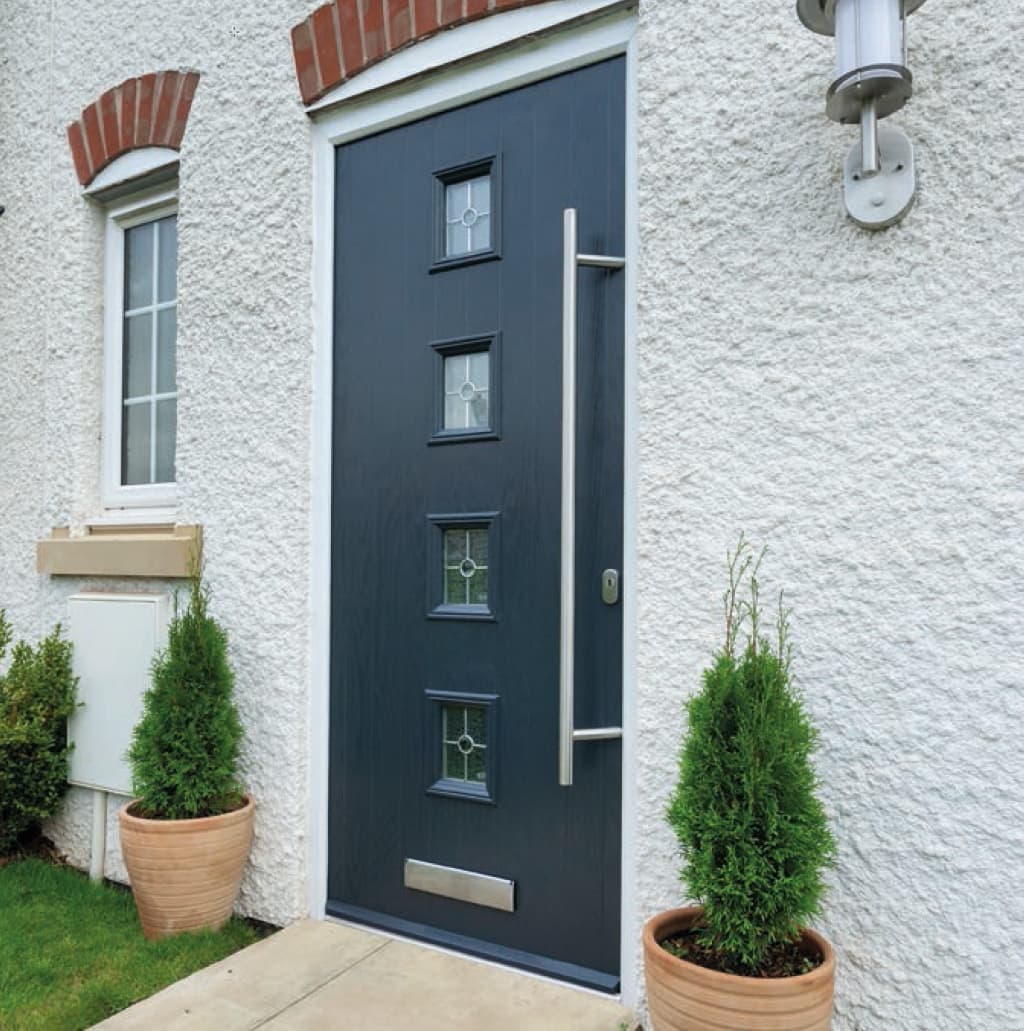
How Secure Are Composite Doors?
Composite doors are exceptionally difficult to break down due to how they are manufactured and the materials used.
Structural integrity and resistance to forced entry
Composite doors are constructed by using a combination of materials, which creates a robust and durable door that will stop even the most sustained attempts at forced entry.
Advanced locking systems
Composite doors provide advanced security thanks to the inclusion of multipoint locks with two hooks, two finger bolts, and a deadbolt fitted as standard.
Comparison of security features with other door types
Composite doors are known for their robust security due to the blend of materials used in their construction, including PVC, wood, insulating foam, and glass-reinforced plastic (GRP). The amalgamation of these materials creates a sturdy, hard-to-break door. Additionally, composite doors often come with high-security locking systems, further bolstering their ability to protect your home.
UPVC Doors
UPVC doors offer a decent level of security. They are durable and hard to break down. Many come with multi-point locking systems for added security. However, their security isn’t quite as high as composite or steel doors due to the plastic material, which can be less resilient against determined intruders.
Wooden Doors
Traditional wooden doors can provide good security, particularly if they are made from solid hardwood. However, they can be susceptible to weathering and, over time, may become less secure if not properly maintained. The strength of a wooden door can also depend on its thickness and the quality of its locks.
Steel Doors
Steel doors are arguably the most secure of all door types. Their inherent strength makes it extremely difficult for potential intruders to break through. They usually come equipped with heavy-duty lock systems and reinforced frames. However, steel doors may lack the aesthetic appeal of other door types, and can be prone to rust if not properly cared for.
In conclusion, while composite doors may not be as intrinsically strong as steel doors, their combination of materials and high-quality locking systems can provide excellent security that rivals steel doors and surpasses UPVC and wooden doors. Furthermore, composite doors offer a balance between security, aesthetics, durability, and energy efficiency, which is why they are often a popular choice for many homeowners.
Additional security enhancements are available
Composite doors can be manufactured with many security enhancements, including internally beaded glazing, solid foam core, and durable fibreglass coating. For extra security, you could add:
A door chain
A chain that will stop the door from fully opening, providing you with peace of mind that it will be harder for someone to gain entry into your home.
A spy hole
A spyhole is a cheap and easy way to operate extra security in your home. This lets you look closely at who is at the door, giving you the choice of whether to let them in or not.
Install a security strike plate
This is used to protect your door jamb, which is an area prone to intruders entering. The strike plate will act as a barricade to your door, so installing one will bolster your door’s security. Similar to a spyhole, they are easy to install and are sold at an affordable price.
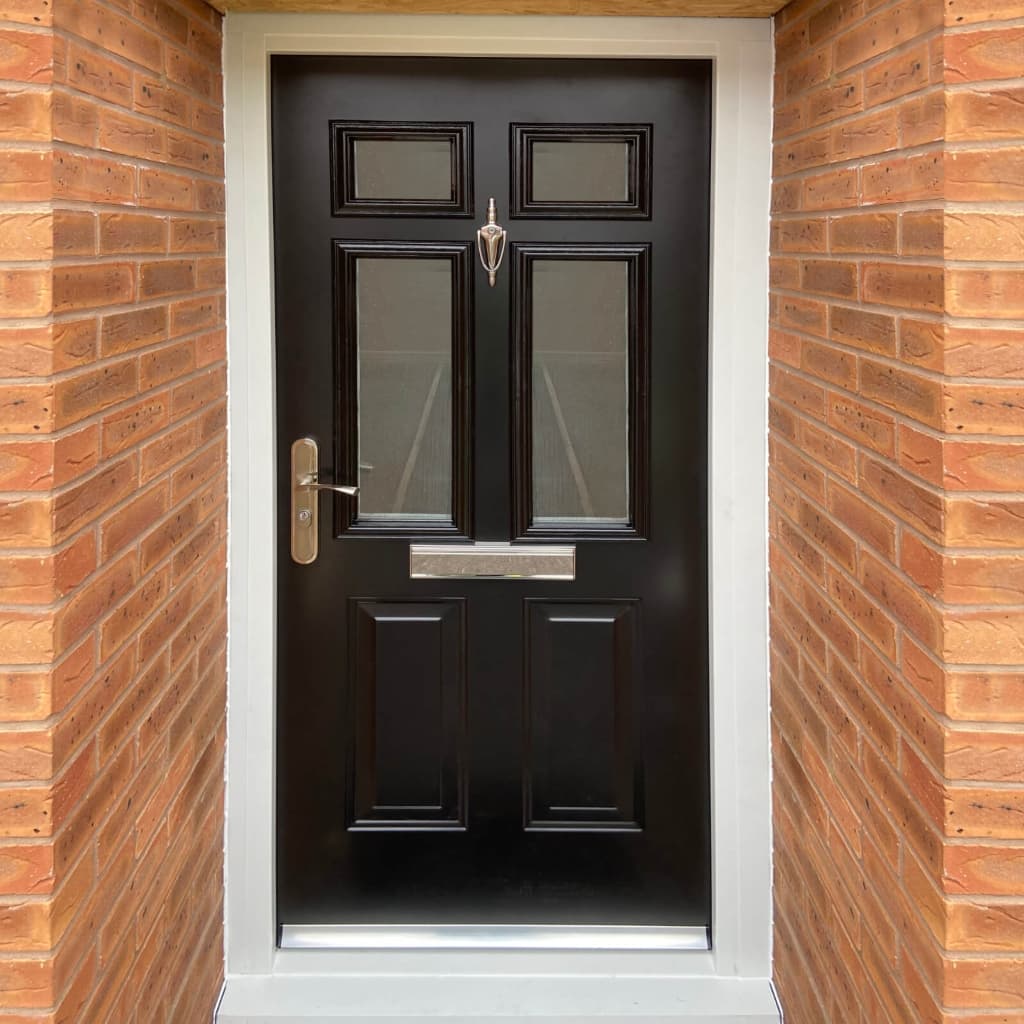
The Aesthetics of Composite Doors
Composite doors are designed to maximise the aesthetic appearance and to look as aesthetically pleasing as traditional wooden doors.
The Aesthetics of Composite Doors
As composite doors are often made-to-measure or cut to fit by manufacturers, this gives customers the chance to design their dream front door from scratch. Manufacturers will have a wide variety of colours, textured glass, and furniture finishes available, allowing you to have a door that suits your home.
From classic designs to urban styles, double doors, and stable doors, composite doors can be manufactured in many styles. They can also come in various colour palettes, from modern brights for newer properties to the more traditional rosewood and oak to suit traditional heritage homes.
Customisation options
Bespoke composite doors allow for customisation. Customers can refine every element of a new composite door. From the colour and finish to the glazing style and hardware accessories. You can also retain your home’s existing style by using accessories in the same style. You could also update the look and feel of your home with a door customised to suit your new look.
How do composite doors compare to traditional wooden or uPVC doors in terms of appearance?
A composite door can almost perfectly replicate the appearance of a wooden door, offering you the same aesthetic and look that a traditional wooden door lends to your home.
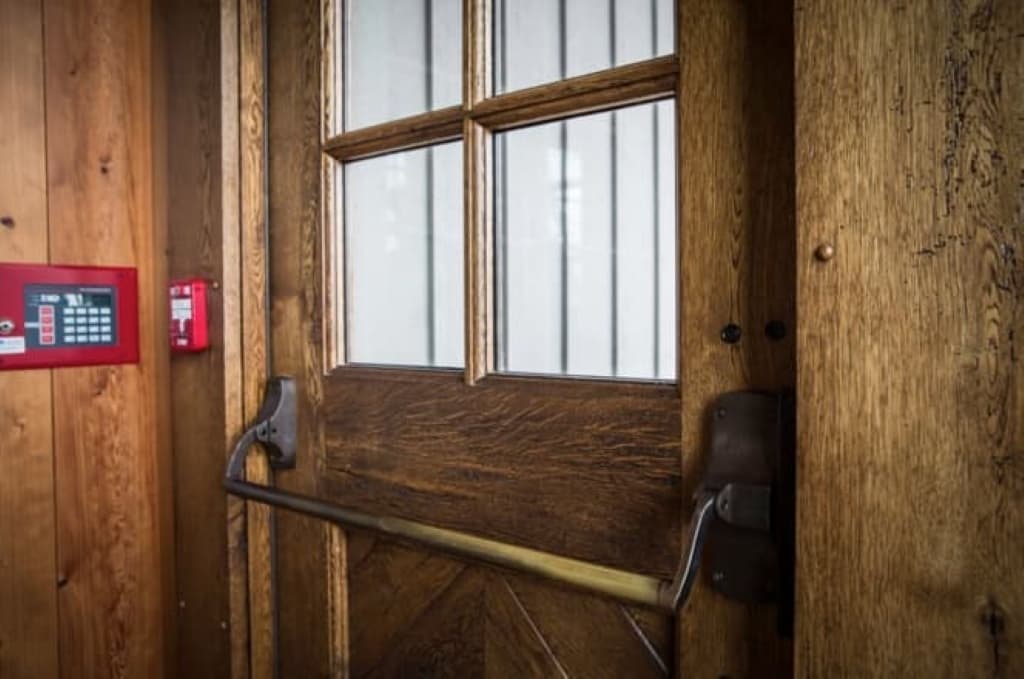
Image: pixabay.com
Composite Doors vs. Other Door Types
Composite doors combine several high-performance components to keep your property safe, aesthetically pleasing and thermally efficient all through the year. There are many key differences between composite doors and other doors available on the market.
Composite vs. wooden doors
Compared to the level of protection and insulation a composite door provides, authentic wooden doors are unable to offer the same levels of performance. Timber doors are chosen for their sought-after aesthetic and the look they lend to the home, especially for classic or heritage properties. A similar appearance can be achieved with a composite door thanks to the range of bespoke styles available, along with colours and finishes. Therefore, a composite door will provide both modern performance and curb appeal.
Composite vs. UPVC doors
Composite and UPVC doors are the two most popular door types for homeowners where both style and durability is important. UPVC doors are made by encasing an insulated steel frame in un-plasticised polyvinyl chloride (UPVC) to create a sealed unit. This makes the door both strong and thermally efficient. However, they do have a plastic-looking finish, compared to a composite which can emulate a wooden door style and finish. They are a more affordable solution to stylishly secure any home compared with a composite. Composite doors are more secure than UPVC doors because they are twice as thick and filled with a hard core.
Composite vs. steel doors
Steel doors typically include a steel frame and are manufactured by filling a mineral wool, polyurethane, or polystyrene foam core between two double-skin steel leaves. The steel frame and double-skinned leaves ensure the door is secure and won’t warp over time. The core adds another layer of protection with the added insulation. Both options offer an aesthetically pleasing and provide a high degree of security but a basic steel door is just that little bit stronger by design. It will also come with a wider range of security upgrades than a composite door. Standard steel doors are also able to withstand higher temperatures and are generally considered safer in the event of a fire over a standard composite door, especially if they are fire-certified.

Image: pixabay.com
Cost of Composite Doors
The cost of a composite door has been highlighted as one of its disadvantages as it is more expensive than its competitors. Here we look at why this is and whether in the long run, it works out to be cost-effective.
Factors influencing the cost
When it comes to the price of a composite door, the main factors that will influence the cost include size, design, hardware, and extras.
Size
The larger your door is, the more materials it will require. Additionally, larger doors tend to require more complicated installation processes than smaller doors.
Design
In regards to the design of your door, this could also have an impact on the price. Whether you choose contemporary or classic, you may end up paying more for particular features, such as decorative glass and panelling.
Hardware
The choice of hardware can also influence the ultimate cost of your composite door purchase. Many people choose to install additional security measures, such as alarm systems or keyless entry systems, which add an extra cost.
Extra Features
Extra features such as side panels or windows can add hundreds to your total bill depending on what type and how many you decide on. Adding insulation or weather stripping can also increase the overall price tag.
Comparison of upfront cost vs long-term value
Prioritising affordability above all else could potentially result in a compromise on quality. It’s vital to consider the longevity and security of the product rather than solely focusing on finding the least expensive option. By opting for high-quality materials, not only will your door have an extended lifespan, but it could also result in long-term savings. This is because the need for frequent replacements due to wear and tear or damage from adverse weather conditions like rainfall or snowfall is significantly reduced when you have a robust composite door.
Cost comparison with other door types
When comparing the costs of different door types — namely, UPVC, wood, steel, and composite — several factors come into play, including the initial price, ongoing maintenance costs, and potential energy savings.
UPVC Doors
UPVC doors are often the most cost-effective choice upfront, making them a popular option for homeowners on a budget. They also have low maintenance costs, as they’re resistant to rotting and fading. However, they may not offer the same level of security and durability as other door types.
Wooden Doors
The cost of wooden doors can vary significantly depending on the type of wood used. Solid hardwood doors are generally more expensive, but they also offer high aesthetic appeal. Maintenance costs can be higher for wooden doors, as they require regular painting or varnishing to prevent warping and rot.
Steel Doors
Steel doors are generally more expensive than both UPVC and wooden doors due to the material’s durability and high security. They have moderate maintenance costs, as they can be prone to rust if not properly treated. However, they can offer substantial long-term value due to their longevity.
Composite Doors
Composite doors tend to be priced higher than UPVC and some wooden doors, but often cost less than steel doors. Their higher initial price can be offset by lower maintenance costs and potential energy savings, due to their excellent insulation properties. They also offer a high level of security and durability, contributing to long-term value.
Overall, while initial costs can guide your decision, it’s crucial to also consider long-term costs and benefits. A cheaper door might save money upfront, but higher maintenance costs or less durability could lead to higher expenses in the long run. It’s a good idea to weigh all factors before making a decision.

Conclusion
Thermally efficient, strong defence against intruders, durable, easy to maintain, available in a range of colours and doors, and draught-proof – these are just some of the many benefits composite doors provide homeowners with. When considering the right door for you and your home, it’s important to weigh up both the benefits and disadvantages. Composite doors are the more expensive option on the market when compared to UPVC, steel, and wooden. However, you must consider whether the advantages of it being an energy-saving option and requiring less maintenance will save you money in the long run.


